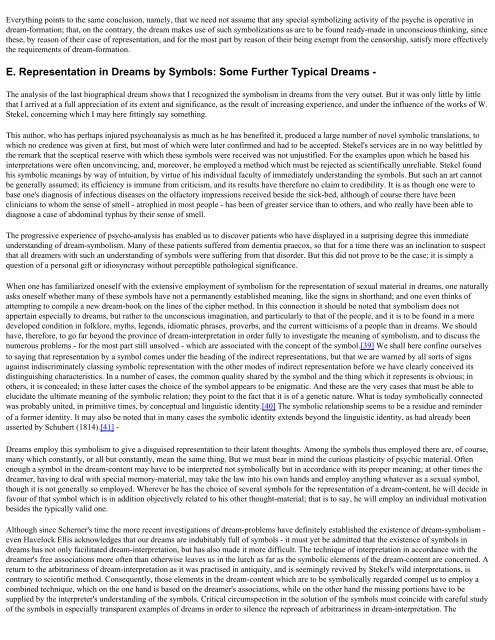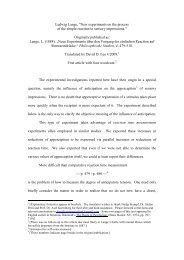The Interpretation Of Dreams Sigmund Freud (1900) PREFACE
The Interpretation Of Dreams Sigmund Freud (1900) PREFACE
The Interpretation Of Dreams Sigmund Freud (1900) PREFACE
You also want an ePaper? Increase the reach of your titles
YUMPU automatically turns print PDFs into web optimized ePapers that Google loves.
Everything points to the same conclusion, namely, that we need not assume that any special symbolizing activity of the psyche is operative in<br />
dream-formation; that, on the contrary, the dream makes use of such symbolizations as are to be found ready-made in unconscious thinking, since<br />
these, by reason of their case of representation, and for the most part by reason of their being exempt from the censorship, satisfy more effectively<br />
the requirements of dream-formation.<br />
E. Representation in <strong>Dreams</strong> by Symbols: Some Further Typical <strong>Dreams</strong> -<br />
<strong>The</strong> analysis of the last biographical dream shows that I recognized the symbolism in dreams from the very outset. But it was only little by little<br />
that I arrived at a full appreciation of its extent and significance, as the result of increasing experience, and under the influence of the works of W.<br />
Stekel, concerning which I may here fittingly say something.<br />
This author, who has perhaps injured psychoanalysis as much as he has benefited it, produced a large number of novel symbolic translations, to<br />
which no credence was given at first, but most of which were later confirmed and had to be accepted. Stekel's services are in no way belittled by<br />
the remark that the sceptical reserve with which these symbols were received was not unjustified. For the examples upon which he based his<br />
interpretations were often unconvincing, and, moreover, he employed a method which must be rejected as scientifically unreliable. Stekel found<br />
his symbolic meanings by way of intuition, by virtue of his individual faculty of immediately understanding the symbols. But such an art cannot<br />
be generally assumed; its efficiency is immune from criticism, and its results have therefore no claim to credibility. It is as though one were to<br />
base one's diagnosis of infectious diseases on the olfactory impressions received beside the sick-bed, although of course there have been<br />
clinicians to whom the sense of smell - atrophied in most people - has been of greater service than to others, and who really have been able to<br />
diagnose a case of abdominal typhus by their sense of smell.<br />
<strong>The</strong> progressive experience of psycho-analysis has enabled us to discover patients who have displayed in a surprising degree this immediate<br />
understanding of dream-symbolism. Many of these patients suffered from dementia praecox, so that for a time there was an inclination to suspect<br />
that all dreamers with such an understanding of symbols were suffering from that disorder. But this did not prove to be the case; it is simply a<br />
question of a personal gift or idiosyncrasy without perceptible pathological significance.<br />
When one has familiarized oneself with the extensive employment of symbolism for the representation of sexual material in dreams, one naturally<br />
asks oneself whether many of these symbols have not a permanently established meaning, like the signs in shorthand; and one even thinks of<br />
attempting to compile a new dream-book on the lines of the cipher method. In this connection it should be noted that symbolism does not<br />
appertain especially to dreams, but rather to the unconscious imagination, and particularly to that of the people, and it is to be found in a more<br />
developed condition in folklore, myths, legends, idiomatic phrases, proverbs, and the current witticisms of a people than in dreams. We should<br />
have, therefore, to go far beyond the province of dream-interpretation in order fully to investigate the meaning of symbolism, and to discuss the<br />
numerous problems - for the most part still unsolved - which are associated with the concept of the symbol.[39] We shall here confine ourselves<br />
to saying that representation by a symbol comes under the heading of the indirect representations, but that we are warned by all sorts of signs<br />
against indiscriminately classing symbolic representation with the other modes of indirect representation before we have clearly conceived its<br />
distinguishing characteristics. In a number of cases, the common quality shared by the symbol and the thing which it represents is obvious; in<br />
others, it is concealed; in these latter cases the choice of the symbol appears to be enigmatic. And these are the very cases that must be able to<br />
elucidate the ultimate meaning of the symbolic relation; they point to the fact that it is of a genetic nature. What is today symbolically connected<br />
was probably united, in primitive times, by conceptual and linguistic identity.[40] <strong>The</strong> symbolic relationship seems to be a residue and reminder<br />
of a former identity. It may also be noted that in many cases the symbolic identity extends beyond the linguistic identity, as had already been<br />
asserted by Schubert (1814).[41] -<br />
<strong>Dreams</strong> employ this symbolism to give a disguised representation to their latent thoughts. Among the symbols thus employed there are, of course,<br />
many which constantly, or all but constantly, mean the same thing. But we must bear in mind the curious plasticity of psychic material. <strong>Of</strong>ten<br />
enough a symbol in the dream-content may have to be interpreted not symbolically but in accordance with its proper meaning; at other times the<br />
dreamer, having to deal with special memory-material, may take the law into his own hands and employ anything whatever as a sexual symbol,<br />
though it is not generally so employed. Wherever he has the choice of several symbols for the representation of a dream-content, he will decide in<br />
favour of that symbol which is in addition objectively related to his other thought-material; that is to say, he will employ an individual motivation<br />
besides the typically valid one.<br />
Although since Scherner's time the more recent investigations of dream-problems have definitely established the existence of dream-symbolism -<br />
even Havelock Ellis acknowledges that our dreams are indubitably full of symbols - it must yet be admitted that the existence of symbols in<br />
dreams has not only facilitated dream-interpretation, but has also made it more difficult. <strong>The</strong> technique of interpretation in accordance with the<br />
dreamer's free associations more often than otherwise leaves us in the lurch as far as the symbolic elements of the dream-content are concerned. A<br />
return to the arbitrariness of dream-interpretation as it was practised in antiquity, and is seemingly revived by Stekel's wild interpretations, is<br />
contrary to scientific method. Consequently, those elements in the dream-content which are to be symbolically regarded compel us to employ a<br />
combined technique, which on the one hand is based on the dreamer's associations, while on the other hand the missing portions have to be<br />
supplied by the interpreter's understanding of the symbols. Critical circumspection in the solution of the symbols must coincide with careful study<br />
of the symbols in especially transparent examples of dreams in order to silence the reproach of arbitrariness in dream-interpretation. <strong>The</strong>



